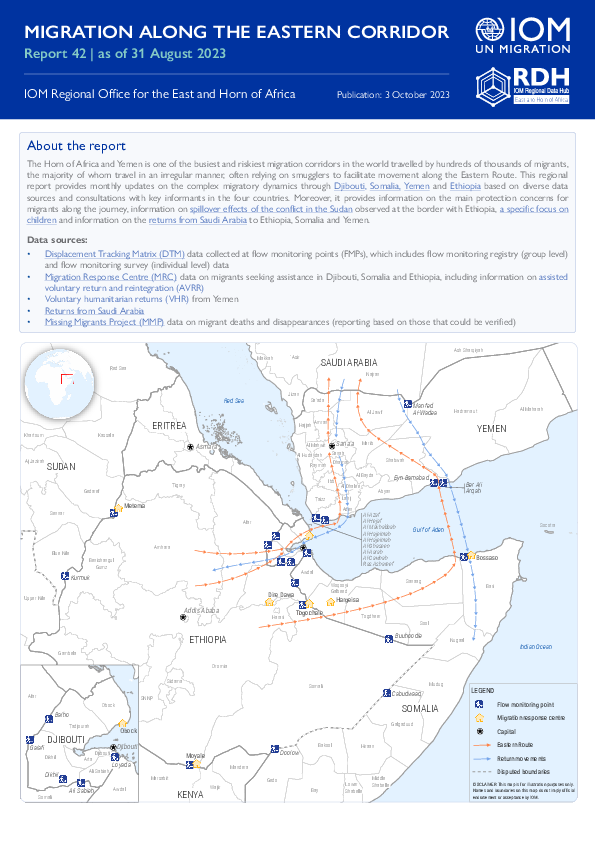-
Countries
-
Data and Analysis
-
Special Focus
-
Crisis Responses

Contact
DTM Nigeria, iomnigeriadtm@iom.int
Language
English
Location
Nigeria
Period Covered
Jul 10 2023
Jul 16 2023
Activity
- Mobility Tracking
- Event Tracking
The DTM Emergency Tracking Tool (ETT) is deployed to track and collect information on large and sudden population movements, provide frequent updates on the scale of displacement and quantify the affected population when needed. As a sub-component of the Mobility Tracking methodology in Nigeria, ETT utilizes direct observations and a broad network of key informants to capture the best estimates of the affected population per location, enabling targeted humanitarian response planning.
Between 10 and 16 July 2023, a total of 1,564 new arrivals were recorded at locations in Adamawa and Borno States. The new arrivals were recorded at locations in Askira/Uba, Bama, Damboa, Dikwa, Gubio, Gwoza, Kaga, Kala/Balge*, Mafa and Ngala Local Government Areas (LGAs) of the most conflict-affected Borno State and in Fufore, Hong, Lamurde, Maiha, Michika, Mubi North, Mubi South, Yola North and Yola South LGAs of Adamawa State.

Contact
DTM Nigeria, iomnigeriadtm@iom.int
Language
English
Location
Nigeria
Period Covered
Jul 03 2023
Jul 09 2023
Activity
- Mobility Tracking
- Event Tracking
The DTM Emergency Tracking Tool (ETT) is deployed to track and collect information on large and sudden population movements, provide frequent updates on the scale of displacement and quantify the affected population when needed. As a sub-component of the Mobility Tracking methodology in Nigeria, ETT utilizes direct observations and a broad network of key informants to capture the best estimates of the affected population per location, enabling targeted humanitarian response planning.
Between 3 and 9 July 2023, a total of 1,954 new arrivals were recorded at locations in Adamawa and Borno States. The new arrivals were recorded at locations in Askira/Uba, Bama, Damboa, Dikwa, Gwoza, Kaga, Kala/Balge*, Mafa, Monguno and Ngala Local Government Areas (LGAs) of the most conflict-affected Borno State and in Fufore, Hong, Lamurde, Michika, Mubi South, Yola North and Yola South LGAs of Adamawa State.

Contact
DTM Nigeria, iomnigeriadtm@iom.int
Language
English
Location
Nigeria
Period Covered
Jun 26 2023
Jul 02 2023
Activity
- Mobility Tracking
- Event Tracking
The DTM Emergency Tracking Tool (ETT) is deployed to track and collect information on large and sudden population movements, provide frequent updates on the scale of displacement and quantify the affected population when needed. As a sub-component of the Mobility Tracking methodology in Nigeria, ETT utilizes direct observations and a broad network of key informants to capture the best estimates of the affected population per location, enabling targeted humanitarian response planning.
Between 26 June and 2 July 2023, a total of 1,443 new arrivals were recorded at locations in Adamawa and Borno states. The new arrivals were recorded at locations in Askira/Uba, Bama, Damboa, Dikwa, Gwoza, Kaga, Mafa and Ngala Local Government Areas (LGAs) of the most conflict-affected Borno State and in Fufore, Hong, Lamurde, Maiha, Michika, Mubi South, Yola North and Yola South LGAs of Adamawa State.

Contact
DTM Nigeria, iomnigeriadtm@iom.int
Language
English
Location
Nigeria
Period Covered
Jun 19 2023
Jun 25 2023
Activity
- Mobility Tracking
- Event Tracking
The DTM Emergency Tracking Tool (ETT) is deployed to track and collect information on large and sudden population movements, provide frequent updates on the scale of displacement and quantify the affected population when needed. As a sub-component of the Mobility Tracking methodology in Nigeria, ETT utilizes direct observations and a broad network of key informants to capture the best estimates of the affected population per location, enabling targeted humanitarian response planning.
Between 19 and 25 June 2023, a total of 2,260 new arrivals were recorded at locations in Adamawa and Borno states. The new arrivals were recorded at locations in Askira/Uba, Bama, Chibok, Dikwa, Gubio, Gwoza, Kaga, Kala/Balge*, Mafa, Monguno and Ngala Local Government Areas (LGAs) of the most conflict-affected Borno State and in Fufore, Hong, Lamurde, Maiha, Michika, Mubi North, Mubi South, Yola North and Yola South LGAs of Adamawa State.
The Horn of Africa and Yemen is one of the busiest and riskiest migration corridors in the world travelled by hundreds of thousands of migrants, the majority of whom travel in an irregular manner, often relying on smugglers to facilitate movement along the Eastern Route. This regional report provides monthly updates on the complex migratory dynamics through Djibouti, Somalia, Yemen and Ethiopia based on diverse data sources and consultations with key informants in the four countries. Moreover, it provides information on the main protection concerns for migrants along the journey, information on the spillover effects of the conflict in the Sudan observed at the border with Ethiopia, a specific focus on children and information on the returns from Saudi Arabia to Ethiopia, Somalia and Yemen.
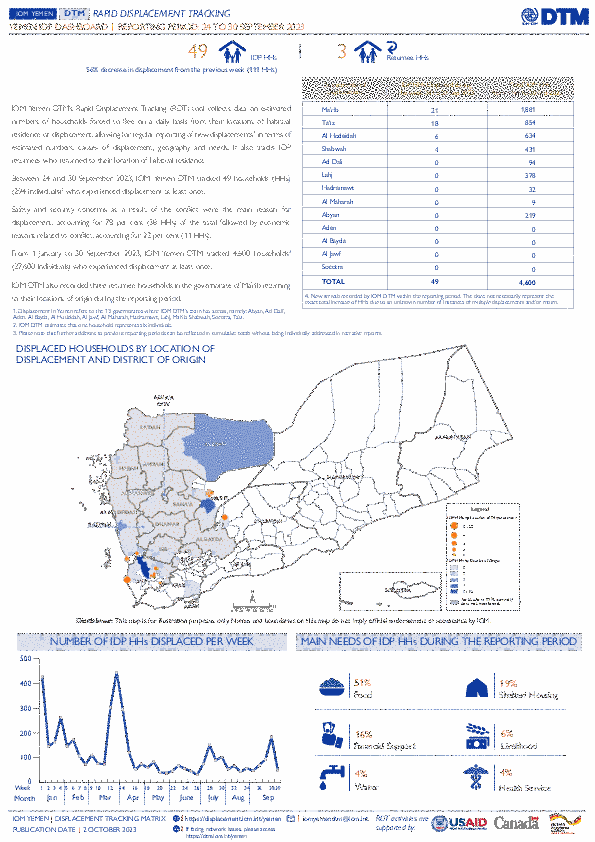
Contact
DTM Yemen, iomyemendtm@iom.int
Language
English
Location
Yemen
Period Covered
Sep 24 2023
Sep 30 2023
Activity
- Mobility Tracking
From 1 January to 30 September 2023, IOM Yemen DTM tracked 4,600 households (HH) (27,600 Individuals) who experienced displacement at least once.
Between 24 and 30 September 2023, IOM Yemen DTM tracked 49 households (294 individuals) displaced at least once. The majority of people moved into/within the following governorates and districts:
- Ma’rib (21 HHs) – Ma’rib City (18 HHs), Ma’rib (3 HHs) districts. Most displacements in the governorate originated from Al Jawf and Al Bayda.
- Ta’iz (18 HHs) – Al Makha (10 HHs), Jabal Habashi (4 HHs), Al Mudhaffar (2 HHs) districts. Most displacements in the governorate were internal.
- Al Hodeidah (6 HHs) – Al Khukhah (4 HHs), Hays (2 HHs) districts. All displacements in the governorate were internal.
The majority of people moved from the following governorates and districts:
- Ta’iz (17 HHs) – Maqbanah (12 HHs), At Ta’iziyah (2 HHs), Al Makha (1 HH) districts.
- Al Hodeidah (8 HHs) – Ad Durayhimi (3 HHs), Jabal Ras (2 HHs), At Tuhayta (1 HH) districts.
- Ma’rib (5 HHs) – Al Jubah (4 HHs), Harib (1 HH) districts.
Contact
DTM Yemen, iomyemendtm@iom.int
Location
Yemen
Activity
- Mobility Tracking
Period Covered
Sep 24 2023 -Sep 30 2023
From 1 January to 30 September 2023, IOM Yemen DTM tracked 4,600 households (HH) (27,600 Individuals) who experienced displacement at least once.
Between 24 and 30 September 2023, IOM Yemen DTM tracked 49 households (294 individuals) displaced at least once. The majority of people moved into/within the following governorates and districts:
- Ma’rib (21 HHs) – Ma’rib City (18 HHs), Ma’rib (3 HHs) districts. Most displacements in the governorate originated from Al Jawf and Al Bayda.
- Ta’iz (18 HHs) – Al Makha (10 HHs), Jabal Habashi (4 HHs), Al Mudhaffar (2 HHs) districts. Most displacements in the governorate were internal.
- Al Hodeidah (6 HHs) – Al Khukhah (4 HHs), Hays (2 HHs) districts. All displacements in the governorate were internal.
- Ta’iz (17 HHs) – Maqbanah (12 HHs), At Ta’iziyah (2 HHs), Al Makha (1 HH) districts.
- Al Hodeidah (8 HHs) – Ad Durayhimi (3 HHs), Jabal Ras (2 HHs), At Tuhayta (1 HH) districts.
- Ma’rib (5 HHs) – Al Jubah (4 HHs), Harib (1 HH) districts.
Population Groups
Survey Methodology
Unit of Analysis Or Observation
Type of Survey or Assessment
Keywords
Geographical Scope
Administrative boundaries with available data
The current dataset covers the following administrative boundaries
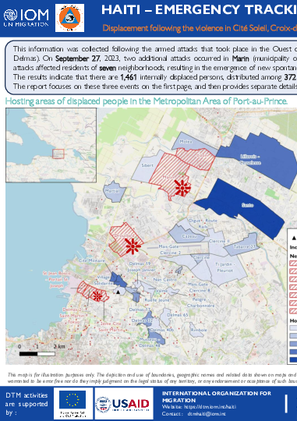
Contact
dtmhaiti@iom.int
Language
English
Location
Haiti
Period Covered
Sep 26 2023
Sep 29 2023
Activity
- Mobility Tracking
- Event Tracking
This information was collected following the armed attacks that took place in the Ouest department on September 26, 2023, specifically in the Delmas 2 neighborhood (municipality of Delmas). On September 27, 2023, two additional attacks occurred in Marin (municipality of Croix-Des-Bouquets) and the Cité Douillard neighborhood (municipality of Cité Soleil). These attacks affected residents of seven neighborhoods, resulting in the emergence of new spontaneous displacement sites. Assessments were conducted by contacting key informants via telephone. The results indicate that there are 1,461 internally displaced people, distributed among 372 households. Among them, 15 individuals are residing in one site, equivalent to three households. The report focuses on these three events on the first page, and then provides separate details for each event on the subsequent three pages.
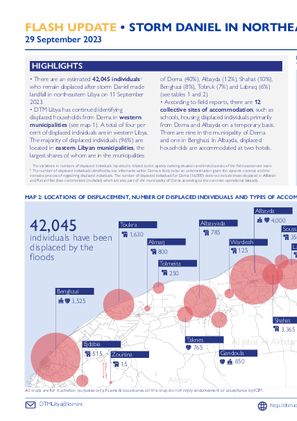
Contact
DTM Libya, DTMLibya@iom.int
Language
English
Location
Libya
Snapshot Date
Sep 29 2023
Activity
- Other
- There are an estimated 42,045 individuals who remain displaced after storm Daniel made landfall in northeastern Libya on 11 September 2023.
- DTM Libya has continued identifying displaced households from Derna in western municipalities (see map 1). A total of four per cent of displaced individuals are in western Libya. The majority of displaced individuals (96%) are located in eastern Libyan municipalities, the largest shares of whom are in the municipalities of Derna (40%), Albayda (12%), Shahat (10%), Benghazi (8%), Tobruk (7%) and Labraq (6%) (see tables 1 and 2).
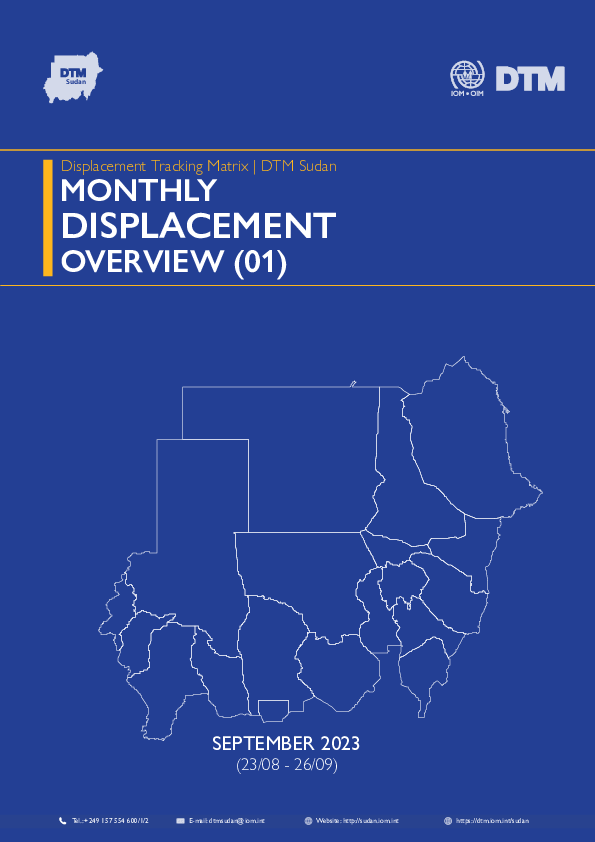
Contact
DTM Sudan, DTMSudan@iom.int
Language
English
Location
Sudan
Snapshot Date
Sep 26 2023
Activity
- Mobility Tracking
- Baseline Assessment
Overview
IOM DTM Sudan is pleased to present its first Monthly Displacement Overview. This publication provides an account of Sudan’s displacement context since 15 April 2023 – outlining population caseloads and movements, as well the present and evolving needs of Sudan’s growing IDP caseload.
Rationale
Recognizing the need for more detailed insights into the IDP situation, including the priority needs, access to services, movement intentions, and demographic breakdowns of the affected population, DTM Sudan has undertaken a comprehensive review of our data collection tool. In collaboration with a wide range of internal and external stakeholders, we have developed a new tool to better inform humanitarian response operations, aligning with the DTM global methodology. Leveraging our extensive network of approximately 300 field-based enumerators and a robust system of over 1500 key informants across the country, DTM has gathered data on IDPs across 4,080 locations, in 167 of Sudan’s 189 localities – across all of Sudan’s 18 states.
Key Findings
- DTM Sudan estimates that 4,295,092 Individuals (856,578 Households) have been recently internally displaced.
- IOM DTM also reports that an estimated 1,190,633 mixed cross-border movements have been made into neighbouring countries.
- During the previous month, field teams have reported heavy clashes between RSF and SAF forces in the capital, as well as the state capitals of South Darfur and North Darfur. Additionally, inter-communal conflicts have been observed across West Darfur.
- Since 15 April 2023, 45% of the IDP caseload has sought refuge in the Darfur and Kordofan regions, whereas the majority (55%) are observed across the Northern, Eastern, and Central states.
- Just over two-thirds of the IDP caseload are seeking shelter with the host community.
- While Food Security remains the highest priority need, Health and Non-Food Items are also growing concerns.
